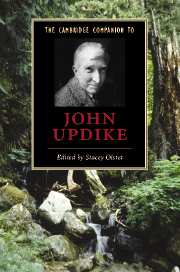Introduction: “A sort of helplessly 50’s guy”
Published online by Cambridge University Press: 28 August 2006
Summary
At the beginning of U and I (1991), news of Donald Barthelme's death prompts Nicholson Baker to contemplate how “disassembled and undirected and simply bereft” he would feel were he to learn of the demise of the writer he considers his “emotional plenipotentiary”: “All I wanted, all I counted on, was Updike's immortality . . . He was, I felt, the model of the twentieth century American man of letters: for him to die would be for my generation's personal connection with literature to die.” Hyperbolic, perhaps, but not inaccurate given the enormously prolific career that John Updike has had since the publication of his first story in 1954: twenty-one novels, fifteen short story collections, seven volumes of poetry, seven essay collections, five children's books, one play, and one memoir. It is no wonder that Baker, who acknowledges having read Updike “very intermittently,” still admits to “thinking about him constantly.”
Updike’s subject, broadly construed, has always been America, where, as the poem “Americana” (2001) states, “beauty is left / to make it on its own, with no directives / from kings or cultural commissars on high” (Americana, 5). Indeed, spanning as it does the entire second half of the twentieth century, Updike’s writing provides a historical roadmap that traces the changes undergone by the nation since the end of the Second World War: beginning with the regionalism of the autobiographical short stories and the creation of Olinger as a Pennsylvania equivalent of Faulkner’s Yoknapatawpha and Anderson’s Winesburg, extending to the Cold War whose inception and end frames the epic Rabbit Angstrom tetralogy (1960, 1971, 1981, 1990), and projected forward to a post-holocaust 2020 that is the temporal setting of Toward the End of Time (1997).
- Type
- Chapter
- Information
- The Cambridge Companion to John Updike , pp. 1 - 12Publisher: Cambridge University PressPrint publication year: 2006
- 1
- Cited by



